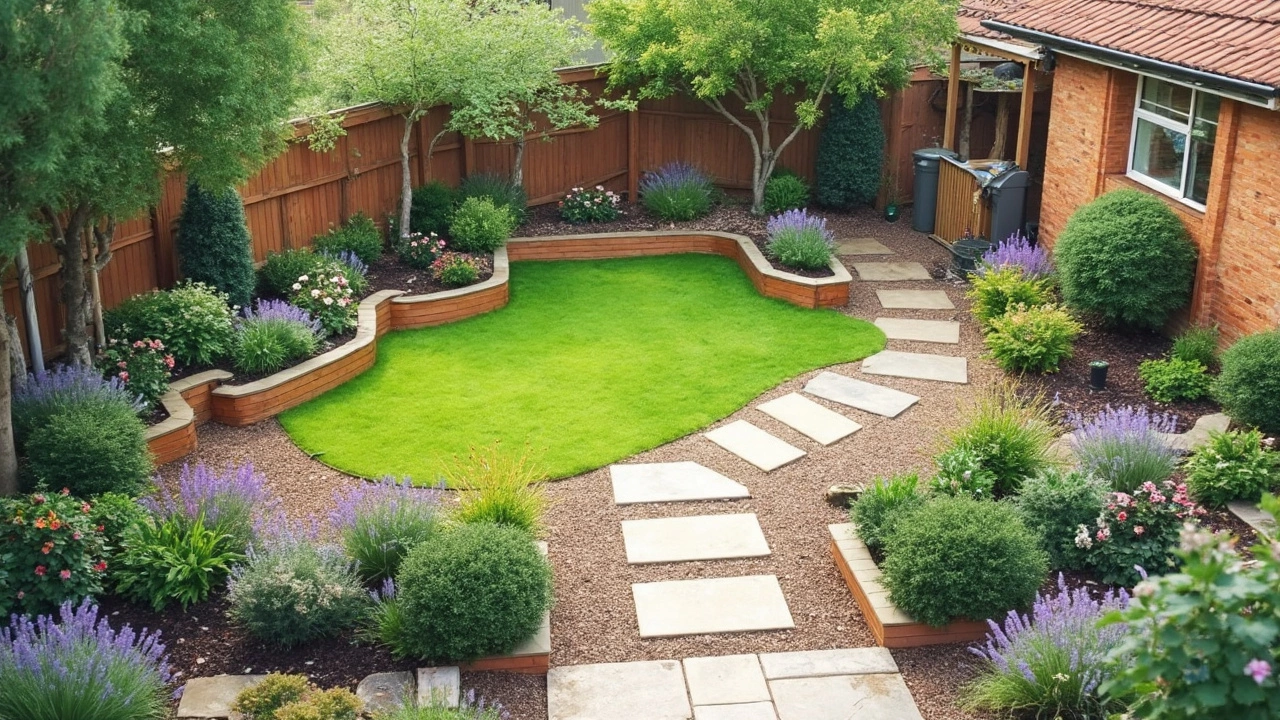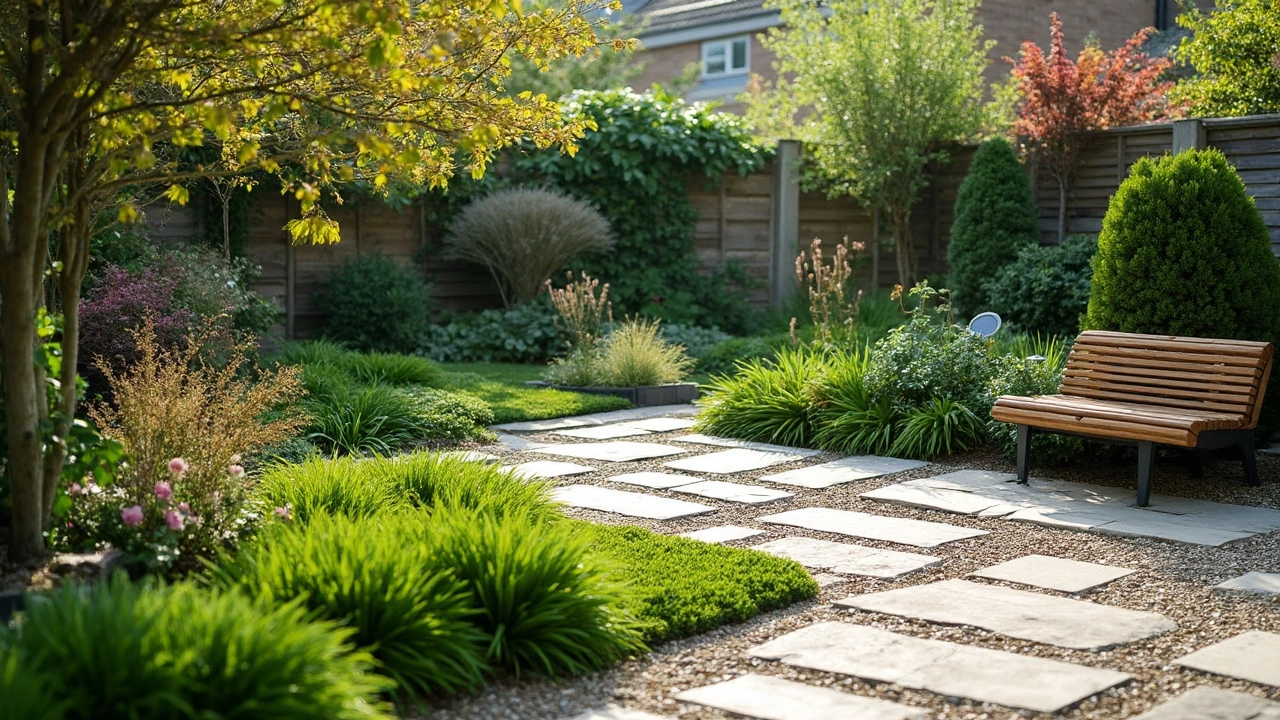If you’ve ever stood in a garden center, sweating over what to buy, you probably wondered if any landscaping can just take care of itself. The truth? Some yards nearly run on autopilot—if you set things up right.
Low maintenance landscaping isn’t about tossing a few rocks in the yard and calling it a day. It’s about making smart choices up front, so you actually spend less time and money down the road. We're talking about picking the right plants, laying down mulch so weeds don’t crash the party, and setting up garden features that practically ignore the calendar.
Curious what real low maintenance looks like? Think fewer chores, way less watering, and a lot less time fussing over plants each week. You don’t have to settle for a boring yard, either. With the right approach, you’ll get a space that looks put-together all season—without babysitting every square inch.
- What Low Maintenance Really Means
- Plant Choices That Practically Care for Themselves
- Hardscaping: Your Secret Weapon
- Soil, Mulch, and Watering Shortcuts
- Common Pitfalls—and How to Dodge Them
What Low Maintenance Really Means
Let’s cut through the rumors: low maintenance landscaping isn’t about having a yard that never needs work. Instead, it’s about getting the kind of setup where most of the heavy lifting is handled by nature, not you. The real goal is to design a space where you only have to step in every so often for basic upkeep like the occasional trim or a once-a-year clean up.
Here’s the core of it. You pick plants that naturally thrive in your climate, so you’re not dragging hoses around every other day. You bring in mulches or groundcovers that keep weeds away, meaning less backbreaking pulling. And you limit how much lawn you need to mow (or skip grass altogether if you want to go ultra-easy).
When folks say "low maintenance landscaping," they usually want to avoid:
- Mowing the lawn every week.
- Daily or even frequent watering.
- Constant weeding.
- Plants that die off every year and need to be replanted.
Want some real numbers? According to a 2024 survey by the National Gardening Association, Americans spend about 70 hours a year on lawn and garden care. With intentional low maintenance designs, yard work can drop by up to 50%.
| Traditional Yard | Low Maintenance Yard |
|---|---|
| Water weekly & mow often | Water monthly & rare mowing |
| Frequent weeding | Minimal weeding |
| Replant annuals each spring | Perennials come back on their own |
The bottom line: low maintenance is about making your yard look good without it turning into a part-time job. Less sweat, more enjoying what you build.
Plant Choices That Practically Care for Themselves
The biggest time-saver in low maintenance landscaping is picking plants that don’t beg for attention. Some plants are just born tough: they deal with heat, skip a drink or two, and never whine about trimming. If you’re tired of fussing with picky flowers or mowing patches that always brown out, it pays to go for easygoing options right from the start.
Here’s what people really mean when talking "set-and-forget" plants:
- Native shrubs: These are geared for your local weather, so they barely notice heatwaves and cold snaps. For example, in much of the US, switchgrass, ninebark, and creeping juniper lead the low-stress pack.
- Drought-tolerant perennials: Plants like Russian sage, blanket flower, and sedum will thrive with little water and bounce back even after rough weeks.
- Ground covers: Tired of battling weeds? Try creeping thyme or mondo grass. Once they fill in, weeds barely stand a chance. Plus, they don’t need mowing.
- Ornamental grasses: Fountain grass or blue fescue look great year-round, need next to no care, and won’t get taken out by a hot summer.
- Evergreens: Boxwoods and dwarf spruce hold their shape without constant pruning. Plus, they add structure all the way through winter.
If you want to see just how much time—or water—you could save, check this out:
| Plant Type | Watering (per week in summer) | Pruning (per year) |
|---|---|---|
| Traditional lawn | 3-4 times | 20+ mowings |
| Native shrub bed | 1 time | 1-2 sessions |
| Drought-tolerant perennials | 1 time | 1 session |
| Ornamental grasses | 0-1 time | 1 session |
Here’s a quick tip: when buying plants, check their USDA hardiness rating on the tag. If it matches your zone or is tougher, you’re onto a winner. Local garden centers usually stock the hardiest options for your area, too, so that’s usually the safest bet if you don’t want gardening to be a second job.

Hardscaping: Your Secret Weapon
Want to seriously cut back on yard work? Hardscaping is the not-so-secret trick most pros swear by. If you swap some of that patchy lawn or needy flowerbed for paths, patios, or even a gravel sitting area, you’ll almost instantly shrink your to-do list. Less mowing, less watering, and zero weeding in those areas.
Here’s what hardscaping really means: you’re adding elements like stone walkways, paver patios, pea gravel, simple decks, retaining walls, and even things like big boulders or a small firepit. These pieces don’t need sunshine, watering, or a trim. Once they’re installed, they just sit there and look good—rain or shine.
The numbers back this up. According to the National Association of Landscape Professionals, hardscaping features like patios and walkways can reduce landscape maintenance by as much as 60%. That’s time saved every single week.
Here’s where to start if you want the biggest impact with the least work:
- Low maintenance landscaping starts with less lawn. Replace grass with mulch beds, decorative gravel, or even artificial turf for a big win.
- Use large pavers set into gravel for walkways—it drains well and weeds barely stand a chance.
- Consider raised beds or retaining walls built from stone or brick. These look sharp and cut down on edging and trimming.
- Edging your planting beds with bricks or metal keeps your yard looking tidy and cuts down on grass spreading into your mulched areas.
Throw in one or two statement pieces—a boulder, a bench, or a modern fire pit—and suddenly your yard feels intentional, not empty.
Amy Hodgson, landscape architect at The Garden Design Company, puts it best:
"Hardscaping shifts the work upfront—after the install, it just needs the occasional sweep or rinse, not hours with a mower or trimmer."In plain English: invest a bit now, and your future self will thank you every weekend.
Soil, Mulch, and Watering Shortcuts
Most people ignore the dirt under their feet, but great soil is the guts of any low maintenance landscaping plan. If you get the soil right from the jump, plants grow with less fuss. You’re aiming for soil that’s loose, drains well, and packs enough organic material so plants don’t keep begging for fertilizer every month. Compost and aged manure? These are your best friends.
Then comes mulch. This stuff is like magic: it holds in water, keeps weeds in check, and saves you loads of time on yard chores. The trick is to lay down two or three inches. Go with bark chips, shredded leaves, or even stone for a rugged look. If you hate weeding, cover the soil heavily before laying mulch—smother those weeds before they even think about popping up.
Watering doesn’t have to be a pain, either. Setting up a basic drip irrigation system takes a weekend but means you’ll barely need to drag out hoses again. Drip lines target water right at the roots and waste way less than sprinklers. Set it on a timer, and you’re basically running your garden from your couch. For tiny areas, recycled soaker hoses are perfect—just snake them through the beds.
Want a sense of how much time and water this actually saves? Check out the numbers below:
| Method | Weekly Watering Time | Water Use (gallons per season) |
|---|---|---|
| Hand Watering | 2 hours | 12,000 |
| Drip Irrigation | 20 minutes | 5,500 |
| Soaker Hose | 30 minutes | 6,800 |
One last tip: test your soil before planting anything. The $20 soil test kit from the hardware store can tell you exactly what your ground is missing—and save you a bunch of guesswork later. Don’t guess, just test. It’ll pay off with plants that thrive and way less work for you every week.

Common Pitfalls—and How to Dodge Them
Plenty of folks dive into low maintenance landscaping and then end up frustrated. Why? They trip over some all-too-common mistakes. Here's a quick reality check so you don't have to rip out plants or redo half your yard later.
Low maintenance landscaping falls apart fast when you pick the wrong plants. If you buy plants just because they look cool at the store, you’re asking for trouble. Plants that aren’t suited for your local climate or soil might just die off—or need constant pampering. Stick with what thrives in your zone. Local garden centers usually have a "native plants" section, and these are gold for a stress-free yard.
Another big blunder is skipping the prep work. Some people lay mulch directly over grass or weeds, thinking it'll smother everything—then wonder why they’re still fighting dandelions all summer. Always clear out existing grass and weeds before mulching. Trust me, it saves you hours down the road.
People also underestimate how much work lawn grass needs. If you keep even a small patch, expect regular mowing, watering, and feeding. Want a real low-effort yard? Shrink the lawn and fill more space with ground covers, pebbles, or beds of shrubs that don’t need weekly babysitting.
Auto-irrigation systems sound awesome, but if they’re not set up right, you either drown the plants or dry them out. Only install drip or soaker systems if you’re ready to tweak them with the seasons. And don’t forget to check for leaks or clogs once a month.
Here’s a quick hit list on how to dodge the usual headaches:
- Choose plants rated for your hardiness zone and sun exposure.
- Prep the soil well: kill weeds, aerate, and add compost if needed.
- Read up on each plant’s watering needs before buying.
- Group plants with similar care together to make watering easy.
- Go for more shrubs and fewer needy annuals for long-term payoff.
If you avoid these mistakes, you’ll have a yard that's actually easy to enjoy. It’s not about shortcuts—it’s about making things easier for your future self.
